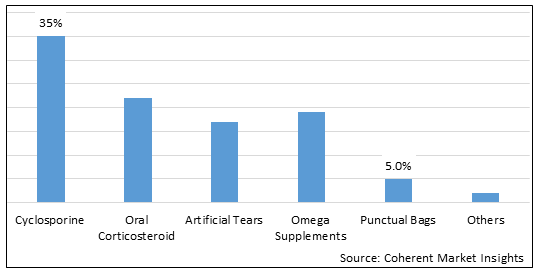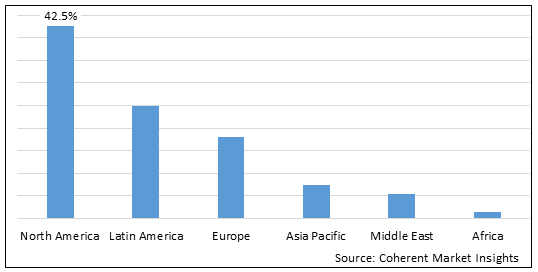Dry eye syndrome can be present in people with autoimmune diseases or other systemic conditions such as diabetes mellitus, Parkinson’s disease, rosacea, rheumatoid arthritis, systemic lupus erythematous, sarcoidosis, Sjögren syndrome, and thyroid disease. Moreover, problems associated with inflammation of the eyelids (blepharitis) or surfaces of the eye can lead to development of dry eyes. Furthermore, certain medications such as antihistamines, antidepressants, decongestants, and blood pressure medications can reduce tear production leading to dry eye symptoms. People who frequently use computer or screens are also at high risk of developing dry eyes, as using screens for a long period can lead to reduced blinking and tear production. Digital device usage has increased significantly in recent years among all age groups, due to extensive use for social and professional purposes.
Global dry eye syndrome market is estimated to be valued at US$ 7,245.3 million in 2022 and is expected to exhibit a CAGR of 16.4% during the forecast period (2022-2030).
Figure 1.Global Dry Eye Syndrome Treatment Market Share (%), by Product Type, 2022

To learn more about this report, Request sample copy
Global Dry Eye Syndrome Treatment Market - Drivers
Increasing organic strategies such as the U.S. Food and Drug Administration approval is expected to propel growth of the global dry eye syndrome treatment market during the forecast period. For instance, in October, 2022, Novaliq, a biopharmaceutical company focusing on ocular therapeutics, announce the approval of New Drug Application (NDA) by the U.S. Food and Drug Administration (FDA) for CyclASol (cyclosporine ophthalmic solution), an anti-inflammatory product for the treatment for the signs and symptoms of dry eye disease (DED).
Furthermore, key companies focusing on product launch of dry eye syndrome treatment are expected to propel growth of the global dry eye syndrome treatment market during the forecast period. For instance, in January 2022, Sun Pharmaceutical Industries, Inc., one of the global specialty generic pharmaceutical company, announced the launch of CEQUA (cyclosporine ophthalmic solution 0.09% w/v), a calcineurin inhibitor immunomodulator indicated to increase tear production in patients with moderate to severe keratoconjunctivitissicca (dry eye).
Dry Eye Syndrome Treatment Market Report Coverage
| Report Coverage | Details | ||
|---|---|---|---|
| Base Year: | 2021 | Market Size in 2022: | US$ 7,245.3 Mn |
| Historical Data for: | 2017 to 2020 | Forecast Period: | 2022 to 2030 |
| Forecast Period 2022 to 2030 CAGR: | 16.4% | 2030 Value Projection: | US$ 24,449.7 Mn |
| Geographies covered: |
|
||
| Segments covered: |
|
||
| Companies covered: |
AbbVie Inc., Novartis AG, Bausch Health Companies Inc., Johnson & Johnson, Inc., I-MED Pharma inc., Santen Pharmaceutical Co., Ltd, AFT Pharmaceuticals, Novaliq GmbH, Otsuka Pharmaceutical Co., Ltd., Sun Pharmaceutical Industries, Inc., Teva Pharmaceutical Industries Ltd., Mitotech, SA, Viatris Inc. |
||
| Growth Drivers: |
|
||
| Restraints & Challenges: |
|
||
Uncover macros and micros vetted on 75+ parameters: Get instant access to report
Figure 2.Global Dry Eye Syndrome Treatment Market Share (%), by Region, 2022

To learn more about this report, Request sample copy
Global Dry Eye Syndrome Treatment– Impact of Coronavirus (COVID-19) Pandemic
Since the COVID-19 virus outbreak in December 2019, the disease has spread to over 100 countries across the globe and the World Health Organization had declared it a public health emergency on January 30, 2020.
COVID-19 has affected the economy in three main ways: by directly affecting production and demand of drugs and vaccines, by creating disruptions in distribution channels, and through its financial impact on firms and financial markets. Due to nationwide lockdowns, several countries, such as China, India, Saudi Arabia, U.A.E., Egypt, and others, faced problems with regard to the transportation of drugs and vaccines from one place to another. Following the outbreak of COVID-19 in December 2019, the disease has spread to over 100 countries across the globe and the World Health Organization declared it a public health emergency. According to the World Health Organization’s report, manifestation of coronavirus (COVID-19) has resulted in more than 636,440,663 confirmed cases infected by COVID-19 worldwide as of 25 November, 2022.
Furthermore, COVID-19 pandemic has a significance impact on amputation due to increase in prevalence of dry eye syndrome. For instance, in June 2022, a research paper was published by Association for Research in Vision and Ophthalmology, a foundation for eye Research providing mentorship, has done Ocular Surface Disease Index (OSDI) survey according to which the prevalence rate of dry eye syndrome during COVID is high due to the wearing the mask, the use of electronic devices and working remotely during COVID- 19 pandemic. The low dry eye syndrome, moderate dry eye syndrome, and severe dry eye syndrome had a prevalence rate of 15%, 77.5 %, and 7.5 %, respectively in the year 2021.
Global Dry Eye Syndrome Treatment Market: Key Developments
In February 2021, Mitotech, SA, a Luxembourg-based single-molecule biotechnology company, in collaboration with Essex Bio-Technology Limited, a bio-pharmaceutical company announce the result of phase 3 clinical study of SkQ1 as a treatment for Dry Eye Disease (DED).The clinical study clearly indicate significant impact of SkQ1on central corneal staining, that is further supported by improvement in visual function to patients suffering from dry eye.
In August 2021, AFT Pharmaceuticals, a specialty pharmaceutical company, provided a clinical study data according to which NovaTears+Omega-3, indicated for dry eye treatment, shows significantly effective treatment for evaporative Dry Eye Disease. The Meibomian Gland Assessment (MGD) score was taken which was improved from an entry level score of 7.1 to 3.0 (p<0.0001) over the course of the study. The latter result supports the hypothesis that the treatment might liquify meibum secretion excreted from the meibomian glands.
Global Dry Eye Syndrome Treatment Market: Restraint
The major factors that hinder growth of the global dry eye syndrome treatment include the lack of awareness of dry eye syndrome in emerging country such as Saudi Arabia. For instance in January 2021, a research article was published by International Journal of Medicine in Developing Countries, according to which a there is lack of awareness of dry eye syndrome among the Saudi Arabian population most of the people did not have routine ophthalmologist visits and tended
to use electronic devices for a long time without a break knowing the risk infecting with dry eye syndrome.
Global Dry Eye Syndrome Treatment market- Key Players
Major players operating in the global dry eye syndrome treatment include AbbVie Inc., Novartis AG, Bausch Health Companies Inc., Johnson & Johnson, Inc., I-MED Pharma inc., Santen Pharmaceutical Co., Ltd, AFT Pharmaceuticals, Novaliq GmbH, Otsuka Pharmaceutical Co., Ltd., Sun Pharmaceutical Industries, Inc., Teva Pharmaceutical Industries Ltd., Mitotech, SA, Viatris Inc., among other prominent players
Share
Share
Missing comfort of reading report in your local language? Find your preferred language :
Transform your Strategy with Exclusive Trending Reports :
Frequently Asked Questions
Select a License Type
Credibility and Certifications

860519526

9001:2015
27001:2022


Joining thousands of companies around the world committed to making the Excellent Business Solutions.
View All Our Clients
US Reciprocal Tax Impact Analysis On Dry Eye Syndrome Treatment Market
Stay updated on tariff changes with expert insights and timely information